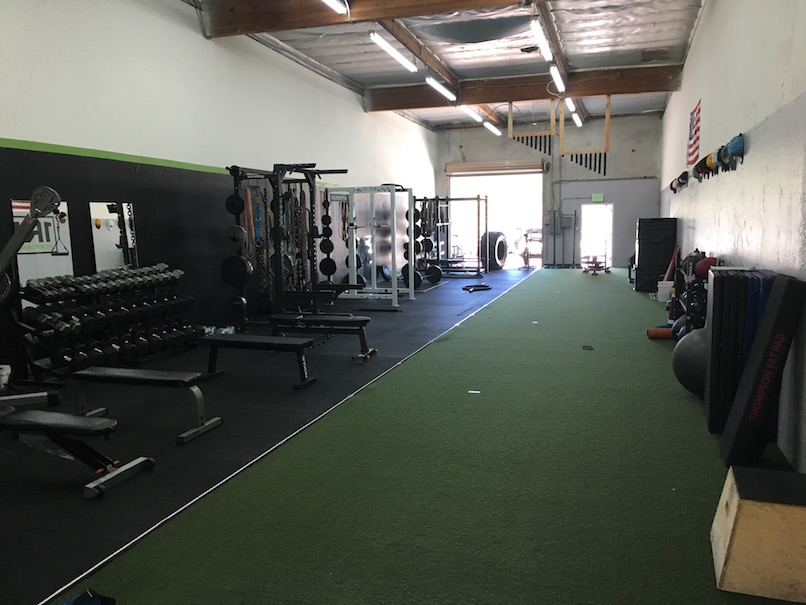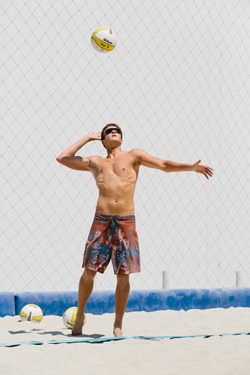Speed Training Post Injury. Becoming the Athlete you were.
How do you get back to full speed after a serious lower body injury? The answer is relatively simple: restore ideal movement, improve strength relative to body mass, and then get explosive, really explosive. Following these three steps will take a little more than just going to your local 24 hour, but if you’re persistent, patient, and believe in the process, you’ll be very happy with what you find at the end of your journey.
To see this process in action, let’s look at one of our pro guys, Connor Hoffman, who is in the middle of the process right now at 1RM Performance.
Connor Hoffman
Mr. Hoffman is a centerfielder currently playing independent baseball in the Frontier league. In one of his games last season, one fly ball in left field changed his and my life. He was tracking the ball and jumped to make the grab and noticed bricks where there should have been pads. He changed his direction in mid air and came crashing down on his left leg. Upon waking up, he noticed his left foot was next to his right hip, thanks to a little compound fracture of his left femur, a dislocated knee, and a torn hamstring that slid up to his hip. During rushed surgery, his femoral artery was accidentally cut, causing surgeons to cut his IT band, to stop the bleeding and save his life.
Eight months later Connor Hoffman shows up at 1RM Performance with a metal rod from his knee to his hip, 12 screws in his knee and hip, and a foot of metal wiring in his knee. From a movement perspective he had an obvious difference in running mechanics and power out right to left side, a squat that loaded his right significantly more than the left, and a lack of internal and external rotation through his left hip. As a baseball player, known for his speed and power, all three of the red flag movement compensations had to be fixed. Luckily Connor also showed up with a hunger and plenty of intensity to help get back to where he was.
So where the hell do you start with an athlete like this? First, make sure your athlete is cleared and ready to go. We all know the athletes who want to get better fast and withhold information about what’s really going on. So make sure you have the clear to get to work, and then follow these steps.
1. Restoring Ideal Movement
Athletes have ideal movement patterns. These patterns are based on their own anatomy, movement development, and athletic history. When it comes to Connor, my goal is to try and figure out what is ideal for him, get him back to it, and make him better. So instead of going into this blind, the assessment is key. Obviously, day one was all assessment for Connor.
Here are the highlights of his first day…
Connor learned how to squat. This is a little more complicated and a little more fun than just teaching a simple squat. Based on his initial squat I was able to see what movement abilities he still had and those that we needed to re-establish. We first moved to a few regressed development positions to make the ol’ hips fire more efficiently with better co-activation. Doing this also allowed me to compare hip internal and external rotation between the left and right side. At the same time we went over and assessed his ability to stay up right between his shoulders and hips on his left and right side. When things were firing cleaner through the lower body, we re-established proprioception with the ground through his feet, (this doesn’t mean standing on a bosu ball!) and got him to own Intra Abdominal Pressure.
He left, crushed and excited for what lay ahead.
Day Two was going over day one and getting under the bar to learn how to maintain these positions under load. Let’s just say that day one ended with 135 lb squats for sets of 10 and a completely new understanding and execution of a squat.
Improve Strength Relative to Body Weight
Day three was Connor’s first day of running. We worked 10 yard sprints to see what his mechanics look like, to see the difference in ground contact time between his left and right side, and what his movement looked like at higher speeds. This allowed me to see what sort of power potential Connor actually had. How?
You could imagine that his right leg looked impressive, but his left, well, that looked about 25 lbs heavier. This was further supported by his horrendous ability to decelerate and the constant beating he took when comparing his times to that of his training partner David Popkins.
But we carried on, and I now know what this young man is capable of.
Under the bar we went. Over the past 6 weeks Connor has been grinding, with and without a shirt on, getting his squat up. With every week his squat continues to climb, his sprint mechanics are continuing to improve, his times are continuing to drop and deceleration gets easier.
Relative strength and Sprint speed.
Why is everything about Connor Hoffman getting better? Well, it’s certainly not an accident. His 1RM is nearing the double body weight range. This is insanely important! My most explosive athletes have the greatest total strength relative to body weight. All my 35“ plus vertical, 9’ plus broad jump, 56” plus box jump, and fastest athletes have two times body weight squats. Naturally, my goal is to get Connor to that level. This past Monday, 6 weeks after walking into the door, he was crushing 285 for 6 sets of 3 at .5 m/s..
But what about the movement work? That is now his warm up. The exercises I found to be most effective at getting him feeling and moving best day one are warm ups every day after.
Getting Explosive
When recovering from an injury, in this case a fractured femur, becoming explosive comes as your strength continues to climb. It’s hard to ask an athlete's body to do something it doesn’t have the capacity to do. If you want to have a 35-inch vertical, you need to generate enough power to get you 35 inches off the ground. This means we need to generate more force, in the form of strength. Remember, Power is Work over time, and work is Force x Displacement.

When it comes to restoring power following a lower body injury, we have to improve an athlete’s Work capacity. Not aerobic or anaerobic capacities, I’m talking work capacity under a bar, generating more force through given ranges of motion. This comes from squatting, benching, pulling, and every other exercise that gets programmed during a training cycle.
When Strength work capacity improves we than move to improve the time variable of the power equation. This means, getting athletes to generate large amounts of force FAST. REALLY FAST.
An athlete’s ability to generate force first comes to their muscle phenotype break down. For example, Connor has previously run a 6.3 60, so you know his phenotype breakdown will definitely be more type IIX than type I. It then comes to training history. If you have an explosive training history, that involves lots of jumping, sprinting, heavy fast lifts, and you play an explosive sport your fibers that could show more IIA show more IIX. Whereas if you were an endurance athlete or sedentary for most of your life your IIA will appear more like type I fibers.
Finally it comes to your current training program. For Connor, we are in a time crunch so I need him to generate a large amount of force fast. To do this, we are using contrast exercises and velocity based training on all of our working squat sets. Currently, on heavy days we are capping at loads .5m/s average velocity. On dynamic days we are capping the load at .8 m/s average velocity, with loads composed of both traditional weight and bands. Following this phase we will be working at .8 m/s on “heavy” days, and 1.0 m/s on his fast days. These two training blocks have previously created explosive monsters and caused massive increases in an athlete's force capacity while training with submaximal loads.
When it comes to restoring athletic abilities post injury, we must be smart, alert, and open to what an athlete is doing. Obviously, the training guidelines for working with an injured athlete listed here are those in a relatively controlled environment, but they are solid in any setting. Take your time to restore quality movement. Build strength and improve your strength work capacity on top of your restored movement qualities. Then, when things are sticking, begin to incorporate more contrast and velocity based exercises into your training blocks, to improve the time and velocity variable of the Power equation.


